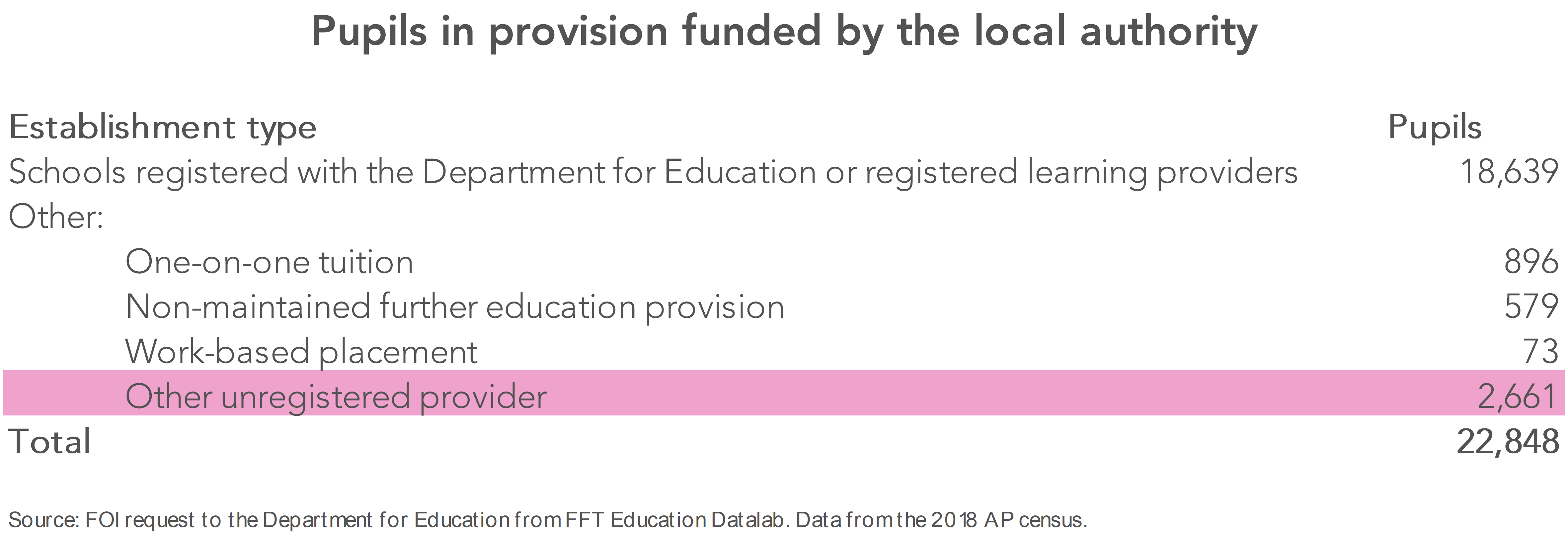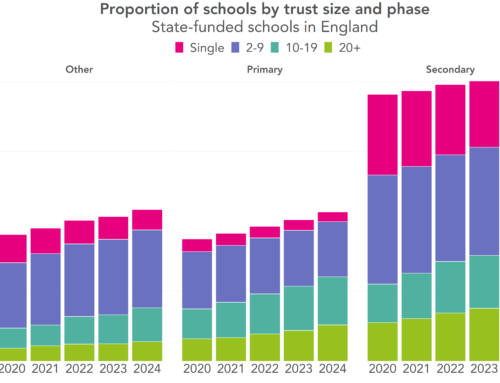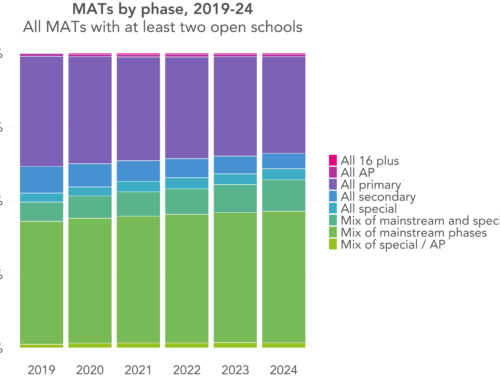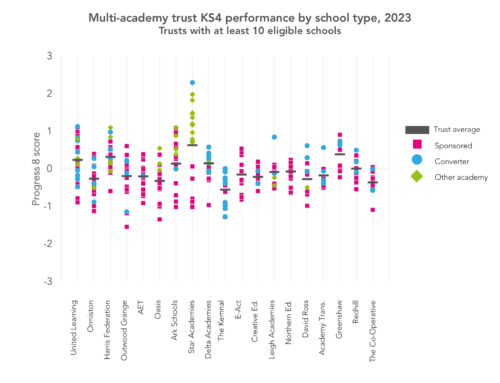Alternative provision has been in the headlines increasingly in recent years, as more questions are asked about the destinations and outcomes of pupils who leave mainstream education.
One such destination is alternative provision – in a setting which can be either registered with the Department for Education, or unregistered. (See the box below for further details, including information on when a provider needs to register.)
We can now contribute to the picture that we have of the alternative provision sector by reporting that there are as many as 2,600 pupils in unregistered alternative provision paid for by local authorities.
At the same time, the Department for Education is unable to say how many unregistered alternative providers there are.
Number of pupils
Alternative provision
Alternative provision can either by registered with the DfE or unregistered.
Registered AP is made up of state AP and registered independent AP. We took a look at the latter last year in conjunction with The Difference, and identified that there were at least 2,500 pupils in registered independent AP.
Alternative providers must register with the DfE if they provide full-time education for:
- five or more pupils of compulsory school age;
- one or more pupils of compulsory school age with an education, health and care plan or statement of special educational needs;
- one or more pupils of compulsory school age who are looked-after by the local council.
But if a provider does not meet any of these criteria – for example, by only providing part-time education – there is no need to register. This is the group that we’re looking at here – unregistered independent AP.
To explain where the figure of 2,600 comes from, we’ll take as a starting point DfE figures from January 2018, which show that there were around 22,848 pupils outside of state education, but for whom local authorities were paying tuition costs.[1]
This covers independent special schools and independent mainstream schools named on a pupil’s education, health and care plan (EHCP). It also covers registered independent alternative provision, unregistered alternative provision and some other smaller types of provision.[2]
A freedom of information (FOI) request that we submitted to the DfE allows us to break this figure of 22,848 down.
Around 18,600 pupils were in independent schools registered with the DfE or establishments otherwise registered as a learning provider. We think that many of this group are pupils with special educational needs with an EHCP.
Of the remaining 4,200 pupils, as many as 2,600 were in unregistered alternative provision – the highlighted row in the table below. We can’t say that the entirety of this group were, as there are a small number of other types of establishments they could be in, including community homes, units where a pupil is being held for their own safety, and, in some cases, detention centres.
A final group of roughly 1,500 pupils were receiving one-on-one tuition, or were in a type of further education or a work-based placement.
Exact numbers are given in the table below.
It’s also worth saying that these figures only cover pupils for whom provision was arranged by the local authority. Placements in unregistered alternative provision organised by schools themselves would not be included.
Number of establishments
The DfE does not know how many unregistered alternative providers there are in England. We know this thanks to a question asked earlier this year in the House of Lords.
Lord Storey: To ask Her Majesty’s Government what estimate they have made of the number of unregistered alternative education providers in England.
Lord Agnew: The information requested is not held centrally.
While Ofsted does not directly inspect unregistered settings, inspectors are expected to consider the progress of pupils who attend off-site provision as part of school and college inspections. In all cases, the local authority or school acting as the alternative provision commissioner, should assure themselves that the provision is delivered by high quality staff with suitable training, experience and safeguarding checks.
A 2012 FOI request to the DfE by another party elicited the response that the Department estimated that there were “several thousand [alternative] providers in England, possibly over 10,000”. Given that the number of state alternative providers is in the low hundreds, and there are not particularly many registered independent alternative providers, this would seem to imply that the DfE previously considered there to be several thousand unregistered alternative providers, though we’d be surprised if there were so many.
Essentially, we know that up to 2,600 pupils are in unregistered alternative provision – at least, in provision that isn’t being paid for directly by schools. We don’t know how big typical providers are, though, so it’s hard to form a view on how many individual providers there are.
In that regard, we’re in the same position as Lord Agnew.
Want to stay up-to-date with the latest research from FFT Education Datalab? Sign up to Datalab’s mailing list to get notifications about new blogposts, or to receive the team’s half-termly newsletter.
1. This had increased to 26,128 in January 2019.
2. Collectively this is what’s known in official figures as local authority alternative provision. That’s a misnomer, though – it covers education for which a local authority is paying a pupil’s tuition fees, whether or not that provision is alternative provision.







It’s also worth saying – and something I neglected to mention explicitly in the post – the DfE doesn’t itself have an assessment of the total number of pupils in unregistered AP, as this question in the House of Commons showed.
Philip, are you able to break this data down by region? I am in the West Midlands. Tony.
Unfortunately not from the data that I have, Tony. In my FOI request I didn’t ask for a breakdown by region (or, I’d have had to ask for it by local authority). I’m not sure if I’d have been able to get that if I’d asked for it, as in some cases LA-level numbers would be small.
I worked in an unregistered ALP and was shocked by poor standards of teaching, support and assessment of the vulnerable children attending.
There seems to be confusion over what defines ‘full time’ provision. Can anyone help?
Many thanks.